Save time and make informed app monetization decisions. Our curated compilation of 20 key app monetization stats provides the insights you need for crafting a successful strategy.
The industry for running mobile apps is growing exponentially. There were 255 billion mobile app downloads in 2022, and as of January 2023, only 3% of apps globally were paid. Yet the mobile app industry is projected to reach a staggering $935.2 billion by 2023.
From this, it’s clear that slapping a cost on app downloads goes against the grain of user sentiment. But beyond what’s obvious, it also implies that other monetization models are more viable than we’d like to think.
Due to a rising demand for immersive experiences across mobile coupled with the culture of instant gratification, brands and marketers are tapping into a new rising demand for app content to drive revenue and growth. From industry giants like Tiktok and Tinder to even smaller companies; everyone’s doing it.
Of course, app users play a key role in any sustainable revenue engine. After all, it’s all about meeting them where they are with compelling, engaging communication.
Still, numerous strategies exist to pick from when looking to profit off apps. In nailing your strategy, app monetization stats from our past and present remain an instructive pool of data to help predict your likely monetization strategy outcome.
20 App monetization stats
Combing through the internet to source them all by yourself can be overwhelming. And so, to help you make informed, smarter, and faster strategic decisions, we’ve compiled 20 app monetization stats featuring the lowdown on all you need to ideate your winning app monetization formula.
Ready? Let’s get right into it!
1. The state of app consumer spend
Let’s crunch the numbers: iOS & android users spent a cumulative $129 billion in 2022, with iOS & Google Play racking up 67% & 38% ($37.3 billion), respectively. 63% of these apps were games.
Elsewhere, iOS’ 2022 subscription revenues rose to $17.1 billion — iOS users made up 77% of that number, suggesting that Apple users are more willing to pay for apps.
2. Freemium for the (monetization) win
As of Feb 2022, the leading iOS apps were either free or freemium, while paid downloads paled in comparison: 2.4% of the best gaming apps and 1.51% in health & fitness.
Finance apps reinforce this trend, with only 11.5% going at a freemium and 88% free. Across the board, 83% of the top-grossing apps embraced a freemium model, while over 17% were free.
3. In-app user purchase: a quick glance
Your app users are never shy to spend in a bid to access premium in-app experiences. Want proof? User spend on in-app purchases in 2020 clocked a whopping $111 billion — a 30.2% YoY growth.
4. Subscription revenue still drives stable revenue
Subscription revenue continues to live up to the billing (no pun intended), and it’s showing no signs of slowing down.
Revenue generated from media and digital content is projected to boom by more than 13.5% as user spend on recurring subscriptions is forecasted to hit the 1.26 trillion mark by Q4 2025.
5. Digital advertising is not dead
Despite fears to the contrary, reaching out to users via ads remains an efficient path to monetization. In 2021, Mobile advertisement spending worldwide was projected to reach $340 billion.
So, there's nothing wrong with displaying a few ads, as long as you’re not botching the UX!
6. Video ads are more effective with incentives
Besides enhancing user engagement and retention, ads are proven to drive revenue according to users. As it turns out, users love a good incentive: 90% of users prefer rewarded videos as an ad unit to others like interstitial video ads.
Video ads are also positively received by users & advertisers alike. So, if you’re in search of the hard data to justify introducing rewards in exchange for views to your higher-ups, this is the one.
7. What’s user engagement like these days?
No point sugarcoating it: there’s no retention without attention. This Localytics study reported the average user retention for mobile apps after a span of 90 days to be 24% (media & entertainment apps)
To increase engagement as a monetization strategy, pepper in engagement magnets to boost the 3 I’s: Interaction, Involvement, and Interest, which could range from activity feeds to gamification, ads, loyalty programs, etc.
8. App localization: to localize or not?
What happens when a segment of users can’t scale the language barrier? Surely, you’re not going to overlook this user segment?
75 billion people worldwide speak English. However, it’s not everyone’s first language: only 25% of users engage with websites written in English despite 52% of all websites written in English.
Enter app localization, an inclusive tactic that involves adapting your app to the culture, language, and preferences of this user segment. (hint: it’s way more than just translation. It also includes optimizing visuals, keywords, and local information that communicates your app’s value).
9. App Store Optimization statistics
Data from AppTweak in 2020 says that in 2020, the US app store’s average Page-View-To-Install conversion rate was 33.7%.
Ad budgets hardly grow on trees. And so, ASO — including localization, keyword optimization, app description, and review/rating — can be an economical way to cut acquisition costs and generate revenue.
10. How effective is cross-promotion?
Does Spotify and Uber’s successful collaboration strike a chord? Cross-promoting apps that share common interests & audiences without being a direct competitor can amplify app reach, thereby accelerating user adoption and monetization.
This Partnerize study found that 54% of organizations attribute partnership to over 20% of company revenue.
11. Average Revenue Per User (ARPU) for mobile apps
Between 2023 and 2027, Statista projects ARPU in E-commerce to increase by $1,578 — over 46.11%.
In 2027, the same forecast predicts that Average Revenue Per User (ARPU) will have increased to $4,999.94, which implies a steady, continuous increase YoY in the E-comms market.
(Statista)
12. Percentage of mobile apps using in-app purchases
Ever wondered how much revenue from in-app purchases makes up the total? Generally speaking, In-app purchases (IAPs) are reported to account for 48.2% of total mobile app earnings.
Expectedly, the gaming niche leads the charge regarding IAPs, with a reported 72% of total earnings. Plus, Tiktok earned $540 million from IAPs to become 2020’s top-grossing mobile app.
(Business of apps), (Invespcro)
13. Average conversion rate for in-app purchases
On average, in-app purchases are said to convert at the rate of 2%-3%.
With that being said, you may want to consider external factors like which app store users are accessing your app from (iOS users are 80% more likely to convert than Android users), user device, and user demography in your decision-making.
14. Average revenue generated by in-app advertising
With no exact figures as of now, let’s visualize this stat by looking at ad revenue in light of potential earnings. From the available data, the top 200 apps on the app store gross $82,500 daily on average and roughly $3,500 for the top 800.
In the US, the average user income from rewarded video ads is $0.02 per impression; $0.16 per impression for interstitials.
(Is), (Monetize more)
15. Percentage of mobile apps using subscription-based monetization models
Like many apps before you, the subscription model can get your app on the fast track to serious monetization. In 2021, 86 out of the 100 highest-earning non-game apps globally incorporated subscription models.
The revenue generated by the top 100 non-game apps based on subscriptions yields a notable % year-over-year (YoY) growth rate of 41%, escalating from $13 billion to $18.3 billion globally.
(Statista), (Sensor tower)
16. Average retention rate for subscription-based mobile apps
There’s a bright outlook for user retention in subscription-based apps.
Going by recent data, the average retention rate for subscription-based mobile apps stands at 35% after a period of 90 days. A retention rate of 35% or above after 90 days is a healthy retention rate for subscription-based mobile apps.
(Business of Apps), (Statista)
17. Growth of subscription-based apps revenue
The ceiling for subscription-based apps looks to be incremental. As of 2021, the revenue of the highest-ranking 100 non-game subscription-based apps globally grew by 41% compared to the previous year, reaching a total of $18.3 billion, up from $13 billion — indicating a 7% points growth rate from 2020 figures.
18. Subscription-based apps revenue share
In 2021, the revenue generated by the top 100 top-grossing non-game subscription-based apps accounted for approximately 14% of the total consumer expenditure on in-app purchases, which amounted to $131.6 billion.
This percentage marked an increase from 2020 numbers, which stood at 11.7%.
19. App Store vs. Google Play subscription revenue
Regarding which marketplace offers more ROI potential, it depends on what you’re looking for. In 2021, the top 100 non-game subscription apps available on the App Store grossed $13.5 billion in revenue, whereas they generated $4.8 billion on Google Play.
Despite Google Play experiencing greater growth, the App Store witnessed nearly 3X the user spend in comparison.
20. Top subscription apps and categories
In 2021, Alphabet's YouTube & Google One emerged as the leading subscription apps in the US and globally in terms of revenue. While subscription video-on-demand (SVOD) platforms such as Disney+ and HBO Max experienced substantial growth.
Elsewhere, popular social media platforms like Twitter, TikTok, and Instagram have also adopted subscription models to keep users engaged and attract content creators as users.
A closer look at the most effective app monetization strategies
While the app monetization stats we’ve shared will inform you how to plug the holes in your revenue buckets, numerous publishers continue to struggle to formulate a winning app monetization strategy.
Here are some of the best monetization strategies known to app publishers:
1. In-app advertisements
Stat attack: This AppSavvy study reports that in-app ads perform 11.4 times better than banner ads on mobile websites.
User traffic can be monetized through banner ads, interstitial video ads, and rewarded ads, among others.
By running targeted ads across different user segments, you can maximize profitability, as long as you don’t frustrate the user experience by bombarding users with upsells or ads.
2. Premium content/subscriptions
Monthly revenue from subscriptions can provide a consistent stream of revenue, but success depends on your ability to cultivate a loyal user base.
Enrich content with premium value and make it accessible only to subscribed users. Also, remember to benchmark your monetization strategy against feedback, user behavior, and industry/market trends for continuous improvement.
3. Data monetization
In light of the declining availability of third-party data, first-party data derived from your app and other channels can be a storehouse of value to your bottom line. However, a substantial volume of data is necessary to make it valuable.
4. In-app purchases
If you offer a product or service, leveraging in-app purchases is an obvious choice for app monetization — IAPs make up 48.2% of total mobile app earnings.
And here’s the good bit: In-app offerings don’t have to be tangible goods. Virtual items like in-game assets, upgrades, or currency can be sold within your app.
5. Freemium model
In simple terms, the freemium model means that users can freely download and utilize the app while providing the option to access premium features or content at a price.
This approach entices users to explore the essential functionalities of the app without charge, with the opportunity to upgrade and obtain supplementary features or exclusive content for a fee.
6. Transaction fees
App monetization through transaction fees is more suited to ‘marketplace’ apps facilitating transactions between users or between users and other service providers.
Some key factors that influence app revenue
Certain factors define the success or otherwise of your monetization strategy. We’ve hand-picked the most crucial ones to consider:
1. User base
The lifeblood of your app growth, your user base’s size and engagement levels play a significant role in revenue, as more engaged users mean more interaction with ads and more purchases.
2. User acquisition and retention
Stable and sustainable revenue growth means walking a fine line between acquiring new users and retaining existing ones.
While tactics like ASO, target ads, and social media campaigns can help you acquire new users, you need an immersive UX, engaging content, and user loyalty to drive user retention.
3. App Store Optimization (ASO)
For more organic downloads, you must optimize your app’s visibility.
App Store Optimization (ASO) techniques — Keyword optimization, engaging app descriptions, appealing screenshots, and positive user reviews — can enhance your app's discoverability and conversion rate, increasing the revenue potential.
4. User Lifetime Value (LTV)
LTV represents the total revenue generated by an average user throughout their stay on the app. Using data, you can leverage insight into user behavior and patterns to spot users with high LTV to target your monetization strategy with.
5. User feedback and iterative improvements
How well do you implement feedback? With more new features and continuous app performance optimizations, you can monetize your app.
6. Market trends and competitor analysis
Analysing market trends and competitor analysis help app publishers stay agile and adapt their monetization strategy to changing market conditions. In turn, this enables informed decisions about new monetization features or existing ones.
7. Platform and device compatibility
If your users cannot access or engage with your app due to incompatibility issues with operating systems, screen sizes, or devices, it can negatively impact your revenue opportunities and the volume of your user base.
Examples of top companies with successful app monetization
1. In-App Purchases
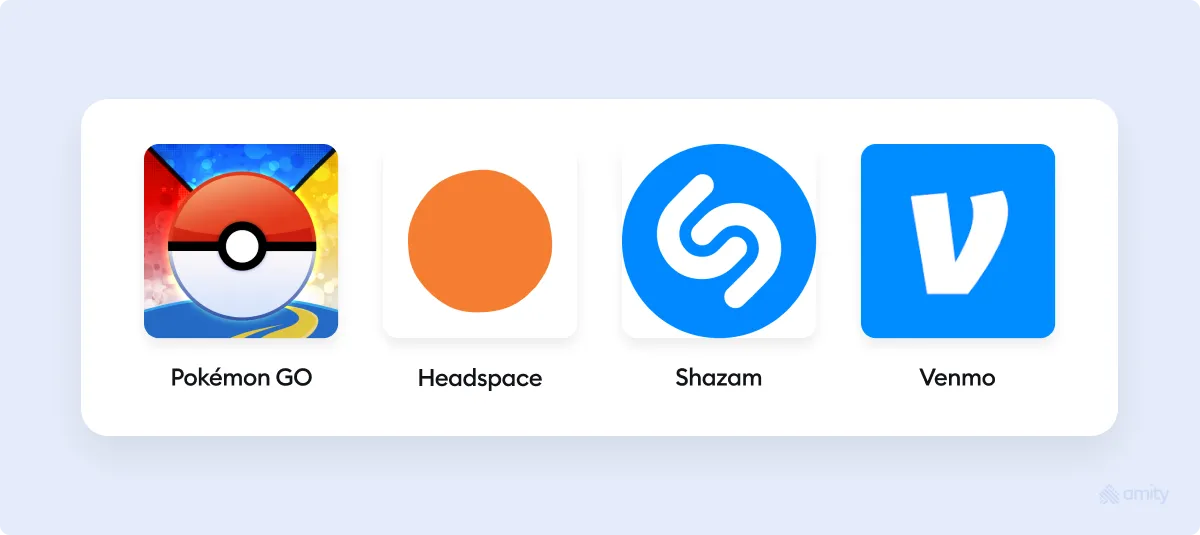
Pokémon GO: An augmented reality game where players capture virtual Pokémon in real life. In-app purchases include Poké Balls, Incense, and Lucky Eggs to supercharge the Pokémon-catching experience.
Headspace: A subscription-based meditation and mindfulness service, headspace that offers in-app purchases for specific meditation packs + courses to cater to individual needs.
Shazam: A music recognition app that helps identify songs. Offers in-app purchases to remove ads, ensuring an uninterrupted UX.
Venmo: This peer-to-peer payment app facilitates instant transfers of funds to a linked bank account. In-app purchases allow users to pay a fee for faster access to their money, bypassing standard transfer times.
2. Freemium
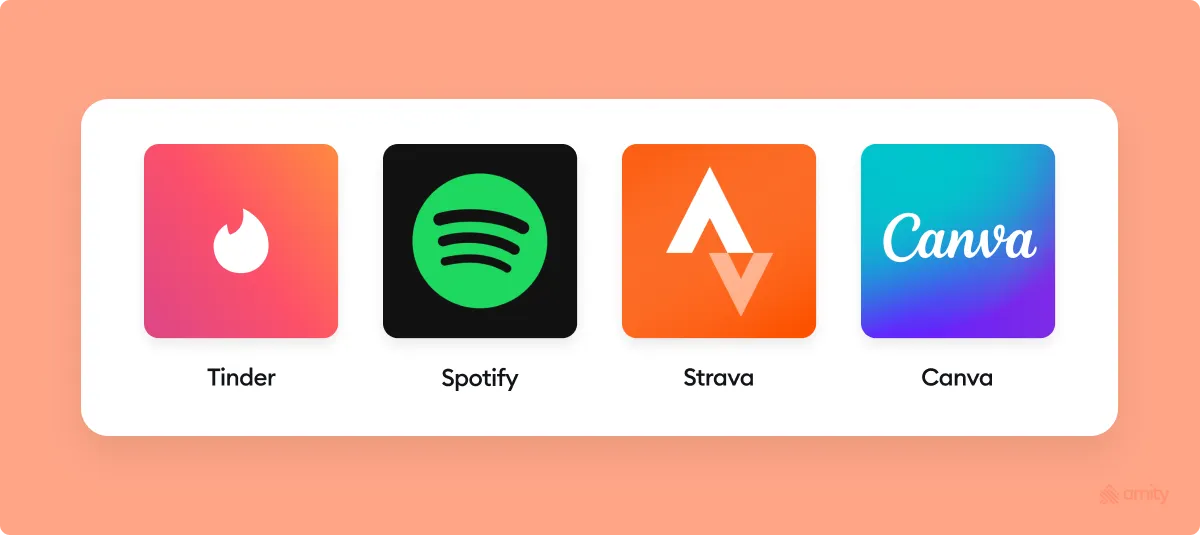
Tinder: While the dating app offers free profile creation, the premium features (unlimited swipes & Super Likes) are sold for a subscription fee.
Spotify: This music streaming platform’s freemium offer includes the basics for free with ads. However, users can go premium for an ad-free experience and other added features.
Strava: Strava offers free basic fitness tracking features, with a premium subscription providing advanced analytics, personalized training plans, and leaderboards.
Canva: On Canva’s graphic design platform, the free version offers limited designs & templates. Canva Pro (the premium subscription) unlocks more advanced design elements, editing tools, and collaboration features.
3. Subscriptions
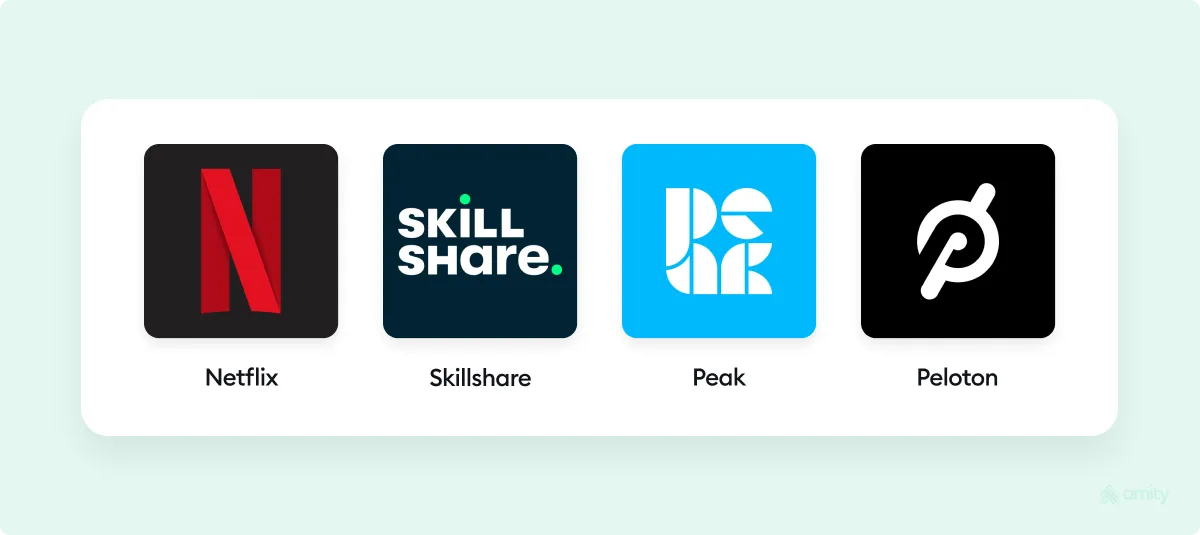
Netflix: The popular video streaming app adopts a subscription service for various movies, TV shows, documentaries, and original content, providing ad-free streaming.
Skillshare: This online learning platform offers a subscription service for video courses from industry pros, teaching users various skills.
Peak: A brain-training app based on a subscription model that offers cognitive exercises & challenging games to enhance memory, attention, problem-solving skills, etc.
Peloton: This subscription-based fitness platform offers live & on-demand workout classes, including interactive cycling, running, strength training, yoga, and meditation sessions accessible from home using the Peloton bike/treadmill.
4. In-App advertising
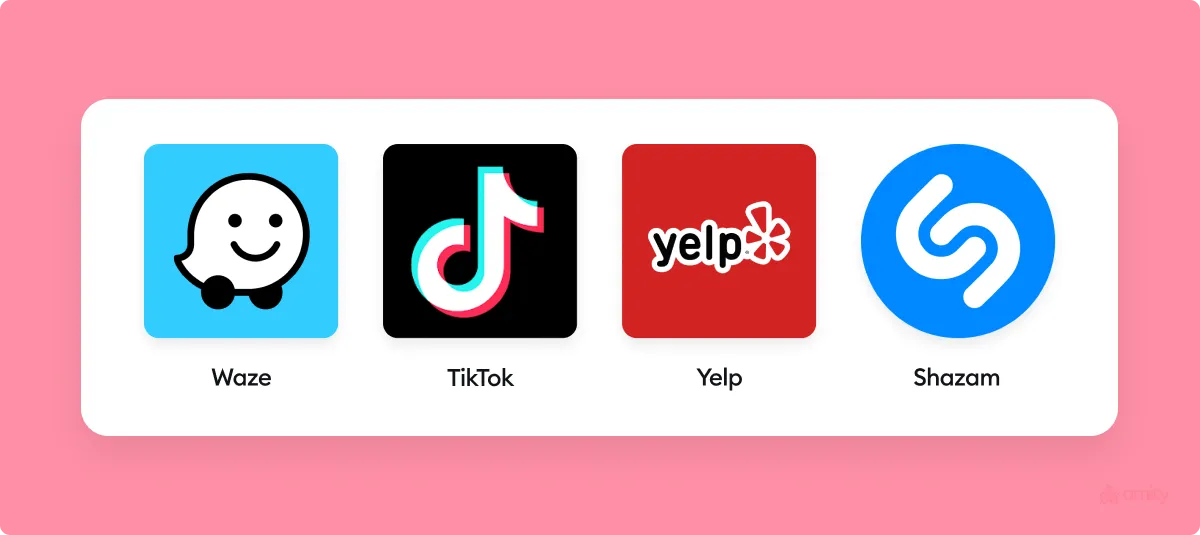
Waze: This navigation app displays location-based ads and sponsored locations while providing real-time traffic information.
TikTok: A popular video-sharing platform with multiple kinds of ads, including sponsored content from brands and in-feed ads in activity feeds.
Yelp: A crowd-sourced review platform offering in-app advertising for local businesses, allowing advertisers to promote their listings and display ads to users searching for specific services or places.
Shazam: Shazam music identification app runs in-app advertising through display ads that appear during the music recognition process or on the app's main screen.
5. Paid apps
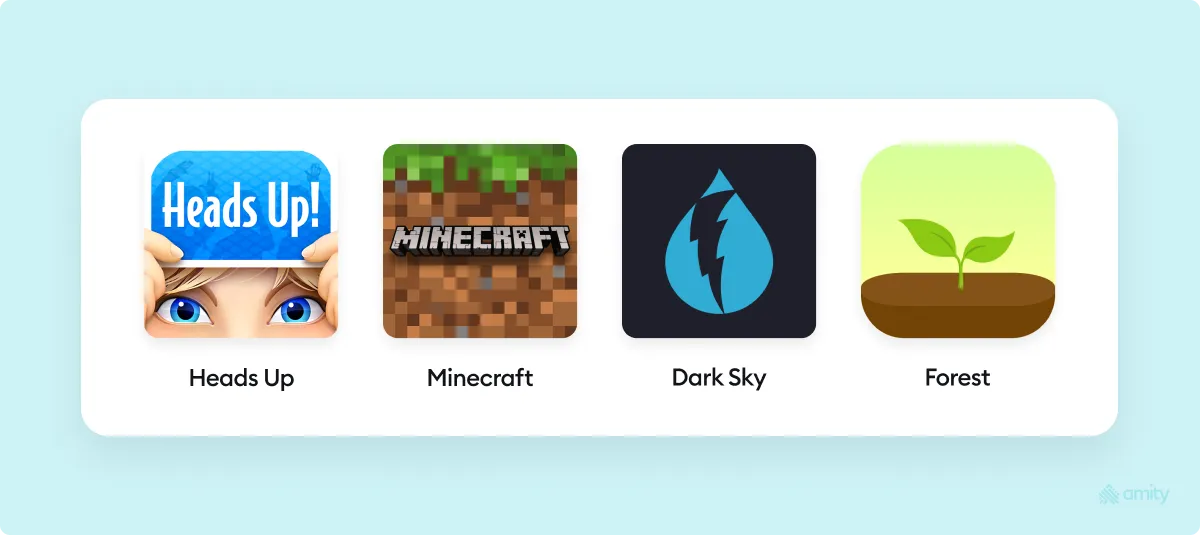
Heads Up!: This party game which uses smartphones for a new spin on classic charades requires users to pay upfront to download and play.
Minecraft: A sandbox video game downloadable and playable through an upfront payment, without additional in-app purchases.
Dark Sky: This app offers accurate hyperlocal weather forecasts with a one-off paid version for ad-free usage & additional features.
Forest: This focus & productivity app gamifies the experience of avoiding distractions. Users pay to download the app, allowing them to grow virtual trees as they stay focused on tasks.
Ready to monetize your app?
Free apps are the new normal. Yet, there’s nothing free in Freetown. You need a monetization strategy to unlock new growth frontiers and expand your app offerings. When it comes to monetization, there’s no one-size-fits-all. The in-app purchases model may favour apps in the gaming niche. Alternatively, in-app ads may be more suited to a news content app. In any case, it all boils down to finding the right strategy for your app and user base — a storehouse of value that’ll be well monetized, considering the app monetization stats we’ve reeled out in the post.
{{monetization="/cta"}}


